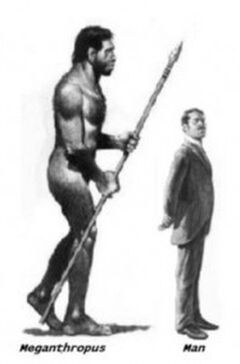| Meganthropus Temporal range: Pleistocene | |
|---|---|

| |
| An artist's illustration & size comparison of Homo erectus palaeojavanicus (A Notceably Older / Less viable Reconstruction) | |
| Scientific classification | |
| Kingdom: | Animalia |
| Phylum: | Chordata |
| Class: | Mammalia |
| Order: | Primates |
| Suborder: | †Haplorhini |
| Family: | Hominidae |
| Genus: | Homo |
| Species: | †H. erectus |
| Subspecies: | †H. e. palaeojavanicus? |
| Trinomial name | |
| †Homo erectus palaeojavanicus? | |
Meganthropus is a name commonly given to several large jaw and skull fragments found at the Sangiran site near Surakarta in Central Java, Indonesia. The original scientific name was Meganthropus palaeojavanicus, and while it is considered invalid until quite recent times, a study in 2019; of tooth morphology found Meganthropus is indeed a valid genus of non-hominin hominid ape, most closely related to Lufengpithecus; as well as the genus name has survived as something of an informal nickname for the fossils. [1]
As of 2005, the taxonomy and phylogeny for the specimens are still uncertain, although most paleoanthropologists consider them related to Homo erectus in some way. However, the names Homo palaeojavanicus and even Australopithecus palaeojavanicus are sometimes used as well, indicating the classification uncertainty. Of particular interest is that the finds were sometimes regarded as those of giants, although that is unsubstantiated.
After the discovery of a robust skull in Swartkrans in 1948 (SK48), the name Meganthropus africanus was briefly applied. However, that specimen is now formally known as Paranthropus robustus and the earlier name is a junior synonym.
Some of these finds were accompanied by evidence of tool use similar to that of Homo erectus. This is the reason Meganthropus is often linked with that species as H. e. palaeojavanicus.
Scientific Interpretation[]
Homo erectus (Outdated)[]
The majority of paleoanthropologists consider the Meganthropus fossil remains as falling within the variation of H. erectus. As Kaifu et al. (2005) note: "If we take the conservative standpoint that all earlier Homo populations that are sufficiently derived from African early Homo belong to H. erectus, the Grenzbank/Sangiran group is allocated to a primitive group of this species." However some[who?] argue that the Meganthropus fossils warrant a separate species or H. erectus subspecies, proposing the names H. palaeojavanicus or H. e. palaeojavanicus based on their overall primitiveness, such as low cranial capacity (Tyler, 2001). Against this view, Wolpoff (1999) argues for strong similarities between earlier and later Javanese fossils and no species nor subspecies distinction.
Australopithecine[]
Robinson (1953) first suggested that Meganthropus (based on the Sangiran 6 mandibular fragment) could be a Southeast Asian representative of robust australopithecines. A similar theory was proposed by Krantz (1975) who argued that Sangiran 6 is: "entirely outside the possible size range of Homo erectus and should be classed as Australopithecus africanus" (i.e. gracile as opposed to robust australopithecine). According to Koenigswald (1973) both robust and gracile australopithecine traits can be found in Sangiran 6: "In certain respects the lower jaw of Meganthropus combines characteristics of A. africanus (premolars) with those of A. robustus (size)."
A study by Orban-Segebarth & Procureur (1983) of the Sangiran 6 mandible also concluded: "Asiatic Meganthropus 'Sangiran 6' has marked australopithecoid traits" but Kramer and Konigsberg (1994) challenge this view. According to Cartmill and Smith (2009): "there is no compelling reason to remove any of the 'Meganthropus' specimens from H. erectus".
Most recent interpretations base models off Pongo (Orangutan) genus.
Other Wikis[]
https://prehistoric-wiki.fandom.com/wiki/Meganthropus
References[]
- https://boneclones.com/product/meganthropus-skull-BC-141
- https://link.springer.com/article/10.1007/BF02438642
- https://www.preprints.org/manuscript/202011.0504/v1
- https://web.archive.org/web/20061002204529/http://www.cartage.org.lb/en/themes/Sciences/LifeScience/PhysicalAnthropology/AbnormalStatures/ThereWereGiants/ThereWereGiants.htm



